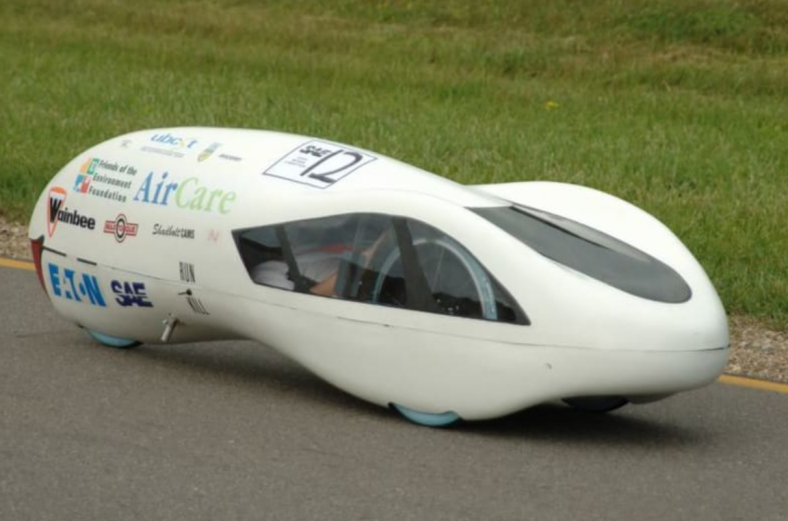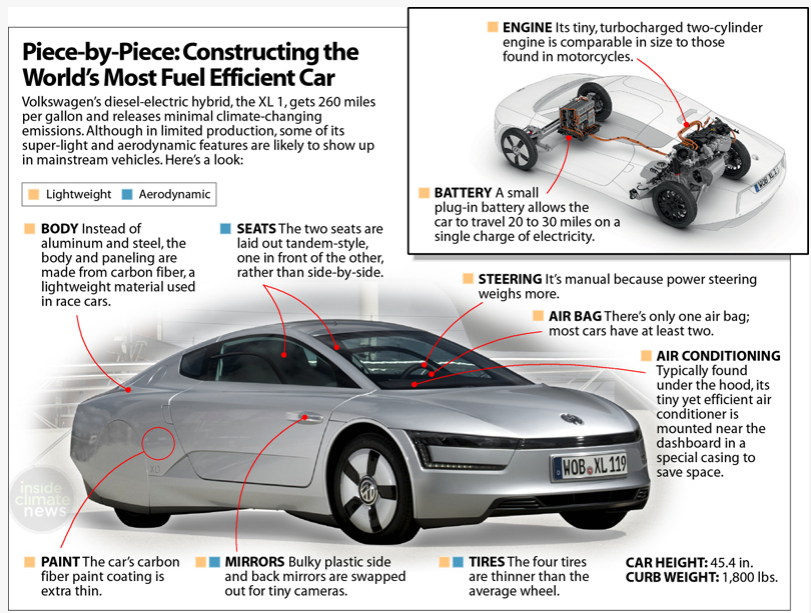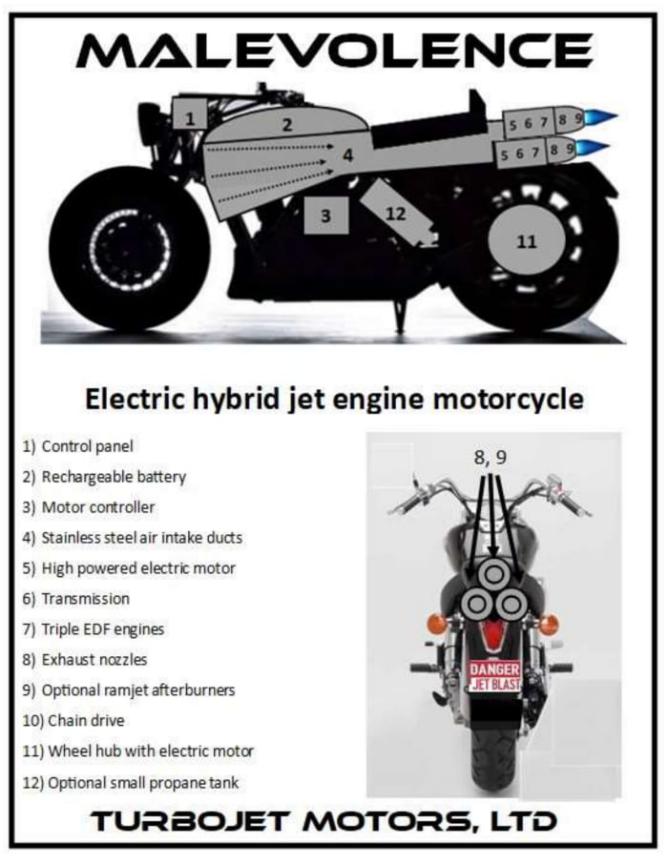1. Introduction
Nowadays, many countries are committed to studying the way to save petroleum. A 2010 Oxford study states that, by 2015, the global petroleum demand will surpass its supply, where 61.7% of the demand comes from the transportation sector. Improving the efficiency of cars is the most important way to save petroleum, and saving petroleum is also one of the most important issues to be solved for every country.
In this paper, three ways of improving car efficiency are introduced. The first is aerodynamic optimization. A group of students from the University of British Columbia (UBC) used this way to make a prototype and got a good result [1]. The second is the use of hybrids and hydrogen-powered fuels. The engine uses diesel and electricity to work. It is low-polluted and can generate more energy. The third is hybrid torque/thrust, an optimal design from the use of a traditional electric motor of lower speeds. By using case studies, this paper enriches the research of aerodynamics and introduces a new way for the future development of cars.
2. Aerodynamic optimization: the Mark VIII prototype
To save petroleum, a group of UBC students created the Mark VIII prototype (as seen in Figure 1), a vehicle that is extremely energy-efficient [1]. When put to the test at the Shell Eco-marathon in April 2013, it achieved a mileage of 588 km/L (1383mpg) [2]. Numerous strategies to manage vortex dynamics have been put forth over the past 20 years, but hot current models have yet to develop an adequate description of the phenomenon of vortex current "shielding" [3]. Today, computational fluid dynamics (CFD) can estimate fluid flow around geometries with large Reynolds numbers. Although it is difficult to use the CFD to make the model for Mark VIII [2], the fluid has a similar physical property. So, the same way can be used to make an air environment and a liquid environment. The engine has an innovative fuel injection technology that instantly vaporizes fuel at the intake valve to decrease fuel waste on the intake wall. To maintain ideal air-fuel ratios over the engine's entire working range, many engine changes are made. The car has a mechanical steering system with a straightforward tilting steering column in keeping with the idea of "simple design". To reduce energy loss when driving, sophisticated assembly clamps and adjustable tie rod linkage guarantee excellent steering alignment [4].
|
Figure 1. The Mark VIII prototype [1]. |
The prototype was built for about $10,000. The cost of the vehicle is mostly increased by development expenses and several custom-made machine parts. However, by implementing mass production of parts, manufacturing costs can be considerably decreased based on economies of scale. The Mark VIII prototype is not yet prepared for the mass market. However, it represents a real vision for the development of sustainable transportation. Most importantly, Mark VIII opened up possibilities and pushed the limits of fuel efficiency by defining new limits on the use of the planet's precious resources. The Mark VIII's first feature is its sleek, streamlined shell. The team was able to alter the shape and curvature of the fuselage in order to produce the most aerodynamic profile by carrying out extensive wind tunnel testing and CFD analysis. To further reduce drag, the driver's position was designed to be foot-first, providing a small frontal area. ANSYS Fluent is a computer program that is used to simulate numerical fluid dynamics and is one of the tools in the ANSYS Workbench software package. The article uses the commercial ANSYS Fluent 2020R1 program, which is ideal for analyzing fluid flows around 2D and 3D geometric solids [5]. Rheology, multiphase flow, flow propagation in open channels, fluid flow (liquids and gases) around rigid and moving walls, magnetism phenomena, modeling of electrical circuits, aerodynamics, energy, thermodynamics, and so on are just a few of the areas where ANSYS Fluent can be used to solve problems. Engineers and businesses in a wide range of sectors can benefit from improved design performance provided by ANSYS simulation technology.
3. Hybrids and hydrogen-powered fuel: Volkswagen's diesel-electric hybrid
The limited-edition diesel-electric hybrid produced by Volkswagen gets 260 mpg and emits one-tenth the amount of greenhouse gas as the average car in the United States. The lightweight and aerodynamic design of the XL 1 and its hybrid engine contribute to the vehicle's fuel economy (Figure 2). One of the few diesel-electric hybrid vehicles that have made their way onto the European market in recent years is the XL 1.
However, even regular diesel cars in the United States have not overcome their decades-old reputation as polluting vehicles. While approximately half of the automobiles in Europe are powered by diesel, less than five percent of US vehicles do so. Mark Gillis, a Volkswagen spokesperson, stated, "the car was never designed for the U.S. market." It has cameras in place of side view mirrors, and its single airbags do not meet security standards in the United States [6].
The lightweight, aerodynamic design of the XL1 and its hybrid engine contribute to its high fuel efficiency. The car's tires are lowered, cranked, and turbocharged for more power at 1,800 pounds, which is less than half the size of the typical American car. The body paint is also extremely thin. Like most hybrids, the XL1's diesel engine works well on the road and is particularly cost-effective for "stop-and-go" or "city" driving. Regulating fuel efficiency is linked to performance issues and sacrifices in biological comfort. The air conditioning, for instance, is subpar, and diesel engines make noise at low RPM. Cars can not climb more than 99mph and slowly reach highway speeds. Diesel engines make up a third of the fuel, are more efficient than petrol engines and emit very little global warming gas. But only recently have they been able to isolate dangerous levels of nitrogen oxides, smoke-induced gases, and small particulate matter. Midway through the 2000s, strict air standards in the United States and Europe compelled automakers to clean up their tailpipes. Today, diesel cars produce slightly less smoke pollution than natural gas vehicles. However, consumer interest remains low in all countries. The fact that diesel costs 40 cents more per gallon than gasoline does not help matters.
In Europe, diesel is cheaper than gasoline. Fuel efficiency regulation is associated with performance defects and biological comfort sacrifices. For example, air conditioning is weak and diesel engines make noise at low RPM. Diesel is less expensive than gasoline in Europe. Despite the fact that automakers are getting ready for fuel economy standards in the United States, executive director of the Maryland Diesel Technology Forum Allen Schaeffer claims that there are currently more than 40 distinct diesel models available in the United States. According to Schaeffer, "consumers are only going to have more choices." He stated that "the diesel market will definitely grow" to double or possibly triple its size.
|
Figure 2. Volkswagen's diesel-electric hybrid, the XL1 [7]. |
By 2025, the Obama administration's fuel economy standards are expected to require automakers to reduce their vehicles' average emissions of carbon dioxide per mile by more than half, from 325 grams to 144 grams. Under the standards, automakers' fleets should average about 55 miles per hour. Europe's emissions are designed to ensure cars emit an average of about 153g of carbon dioxide per mile by 2021; Its fuel efficiency target is 65 miles per hour. The car is less than half the size of a typical American car, weighs 1,800 pounds [8], has smaller tires, and the engine has been turbocharged and turned up to make more power. Even the paint on the body was very thin. The XL 1, like most hybrids, is cheap to park and drive in the city, but its diesel engine is great on the highway.
4. Hybrid torque/thrust: the Malevolence Motorcycle
According to Figure 3, an ideal design makes use of conventional motors at low speeds. To initiate forward power, the rear wheels must be turned by physical torque. Conventional electric motors are the most effective means of propulsion at speeds around 40 MPH [7]. However, as drag, friction, and other obstacles increase beyond this speed, the motor's efficiency begins to decline. However, thrust-based propulsion becomes increasingly effective at this speed, maintaining ever-increasing speeds. If a conventional internal combustion engine (with its associated transmission, exhaust, and other components) if it is not necessary, there is ample room for a spare engine. Air intakes located at the front and bottom of the motorcycle provide power for this kind of ramjet. Mechanical diaphragms and/or diffusers are possible additions. In addition to natural exhaust, an internally mounted EDF impeller jet will assist in significantly increasing airspeed and, ultimately, thrust before ramjets can be utilized. This will accumulate toward the vehicle's rear and be ejected with significantly more force from the rear [9].
|
Figure 3. The electric hybrid jet engine motorcycle [8]. |
5. Conclusion
By studying three cases of future vehicles, namely the Mark VIII prototype of aerodynamic optimization, Volkswagen's diesel-electric hybrid of hydrogen-powered fuel, and the Malevolence Motorcycle of hybrid torque/thrust, this paper explains how to use different ways to remission the energy program, and how to make cars more efficient. From these examples, it can be known that clean energy hybrids and hydrogen-powered fuels have become a future development trend. Fluid mechanics and thermodynamics are used in machines to improve the shape and engine to get more efficient use of energy. Now, energy is still used with low efficiency. Future research can focus on more different types of machines that use the same quantity of fuel but can generate more energy to drive the system.
References
[1]. Currie, K. Ultra Fuel Efficient Vehicle (2014). https://contest.techbriefs.com/2014/entries/sustainable-technologies/5032.
[2]. Žic, E., Černeka, P. and Biluš, I. Hydrodynamic Analysis of the Fluid Flow Around a Symmetric Hydrofoil. Fluid Dyn 56, 460–472 (2021). https://doi.org/10.1134/S0015462821040133.
[3]. Fluid Mechanics and Fluid Power, Editors: T. Prabu, P. Viswanathan, A. Agrawal, J. Banerjee, Proceedings of FMFP 2019.
[4]. Incompressible Newtonian Fluid Mechanics. In: An Introduction to the Mechanics of Incompressible Fluids. Springer, Cham. https://doi.org/10.1007/978-3-031-04683-4_1.
[5]. Pedley, T. J. Current Research in Fluid Mechanics. In: Eberhard, P., Juhasz, S. (eds) IUTAM. Springer, Cham (2016). https://doi.org/10.1007/978-3-319-31063-3_3.
[6]. Žic, E., Introduction to computational fluid dynamics analysis, in Proceedings of the 3rd Summer School of Computational Fluid Dynamics (CFD), Ed. by Bikić, S. and Bukurov, M., Novi Sad: Faculty of Technical Sciences in Novi Sad (2019).
[7]. Hirji, Z. World's Most Fuel-Efficient Car Makes Its Debut (2014). https://insideclimatenews.org/news/09062014/worlds-most-fuel-efficient-car-makes-its-debut/.
[8]. Cikraji, M. Jet Engine Electric Motorcycle Hybrid “Malevolence” (2022). https://contest.techbriefs.com/2022/entries/automotive-transportation/11997.
[9]. Mossa, M. The recent 500th anniversary of Leonardo da Vinci’s death: a reminder of his contribution in the field of fluid mechanics. Environ Fluid Mech 21, 1–10 (2021). https://doi.org/10.1007/s10652-020-09748-4.
Cite this article
Zhou,Z. (2023). Analysis on the Use of Fluid Mechanics and Thermodynamics in Future Vehicles. Theoretical and Natural Science,5,214-218.
Data availability
The datasets used and/or analyzed during the current study will be available from the authors upon reasonable request.
Disclaimer/Publisher's Note
The statements, opinions and data contained in all publications are solely those of the individual author(s) and contributor(s) and not of EWA Publishing and/or the editor(s). EWA Publishing and/or the editor(s) disclaim responsibility for any injury to people or property resulting from any ideas, methods, instructions or products referred to in the content.
About volume
Volume title: Proceedings of the 2nd International Conference on Computing Innovation and Applied Physics (CONF-CIAP 2023)
© 2024 by the author(s). Licensee EWA Publishing, Oxford, UK. This article is an open access article distributed under the terms and
conditions of the Creative Commons Attribution (CC BY) license. Authors who
publish this series agree to the following terms:
1. Authors retain copyright and grant the series right of first publication with the work simultaneously licensed under a Creative Commons
Attribution License that allows others to share the work with an acknowledgment of the work's authorship and initial publication in this
series.
2. Authors are able to enter into separate, additional contractual arrangements for the non-exclusive distribution of the series's published
version of the work (e.g., post it to an institutional repository or publish it in a book), with an acknowledgment of its initial
publication in this series.
3. Authors are permitted and encouraged to post their work online (e.g., in institutional repositories or on their website) prior to and
during the submission process, as it can lead to productive exchanges, as well as earlier and greater citation of published work (See
Open access policy for details).
References
[1]. Currie, K. Ultra Fuel Efficient Vehicle (2014). https://contest.techbriefs.com/2014/entries/sustainable-technologies/5032.
[2]. Žic, E., Černeka, P. and Biluš, I. Hydrodynamic Analysis of the Fluid Flow Around a Symmetric Hydrofoil. Fluid Dyn 56, 460–472 (2021). https://doi.org/10.1134/S0015462821040133.
[3]. Fluid Mechanics and Fluid Power, Editors: T. Prabu, P. Viswanathan, A. Agrawal, J. Banerjee, Proceedings of FMFP 2019.
[4]. Incompressible Newtonian Fluid Mechanics. In: An Introduction to the Mechanics of Incompressible Fluids. Springer, Cham. https://doi.org/10.1007/978-3-031-04683-4_1.
[5]. Pedley, T. J. Current Research in Fluid Mechanics. In: Eberhard, P., Juhasz, S. (eds) IUTAM. Springer, Cham (2016). https://doi.org/10.1007/978-3-319-31063-3_3.
[6]. Žic, E., Introduction to computational fluid dynamics analysis, in Proceedings of the 3rd Summer School of Computational Fluid Dynamics (CFD), Ed. by Bikić, S. and Bukurov, M., Novi Sad: Faculty of Technical Sciences in Novi Sad (2019).
[7]. Hirji, Z. World's Most Fuel-Efficient Car Makes Its Debut (2014). https://insideclimatenews.org/news/09062014/worlds-most-fuel-efficient-car-makes-its-debut/.
[8]. Cikraji, M. Jet Engine Electric Motorcycle Hybrid “Malevolence” (2022). https://contest.techbriefs.com/2022/entries/automotive-transportation/11997.
[9]. Mossa, M. The recent 500th anniversary of Leonardo da Vinci’s death: a reminder of his contribution in the field of fluid mechanics. Environ Fluid Mech 21, 1–10 (2021). https://doi.org/10.1007/s10652-020-09748-4.












